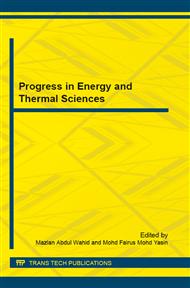[1]
R.P. Singh, S. Pal, S. Krishnamoorthy, P. Adhikary and S.K. Ali, High technology materials based on modified polysassharides. Pure Applied Chemical. 81 (2009) 525-547.
DOI: 10.1351/pac-con-08-08-17
Google Scholar
[2]
J.P. Wang, Y.Z. Chen, X.W. Ge and H.Q. Yu, Gamma radiation-induced grafting of a cationic monomer onto chitosan as a flocculant. Chemosphere 66 (2007) 1752–1757.
DOI: 10.1016/j.chemosphere.2006.06.072
Google Scholar
[3]
X. Wan, Y. Li, X. Wang, S. Chen, and X. Gu, Synthesis of cationic guar gum graftpolyacrylamide at low temperature and its flocculating properties. J. Euro. Poly. 43 (2007) 3655–3661.
DOI: 10.1016/j.eurpolymj.2007.05.037
Google Scholar
[4]
Q. Chang, X. Hao, and L. Duan, Synthesis of crosslinked starch-graft-polyacrylamideco- sodium xanthate and its performance in waste water treatment. Hazardous Material. 159(2-3) (2008). 548–553.
DOI: 10.1016/j.jhazmat.2008.02.053
Google Scholar
[5]
D. Tian & G.Q. Xie, Synthesis and flocculation characteristics of Konjac Glucomannan-g-polyacrylamide. Poly. Bulletin. 61 (2008) 277–285.
DOI: 10.1007/s00289-008-0950-6
Google Scholar
[6]
G. Sen, R. Kumar, S. Ghosh, and S. Pal, A novel polymeric flocculant based on polyacrylamide grafted carboxymethylstarch. J. Carbo. Poly. 77 (2009) 822-831.
DOI: 10.1016/j.carbpol.2009.03.007
Google Scholar
[7]
S. Ghosh, G. Sen, U. Jha and S. Pal, Novel biodegradable polymeric flocculant based on polyacrylamide-grafted tamarind kernel polysaccharide, J. Bior. Tech. 101(2010) 9638 9644.
DOI: 10.1016/j.biortech.2010.07.058
Google Scholar
[8]
Q. Lin, S. Qian, C. Li, H. Pan, Z. Wu and G. Liu, Synthesis, flocculation and adsorption performance of amphoteric starch, J. Carb. Poly. 90 (2012) 275– 283.
DOI: 10.1016/j.carbpol.2012.05.035
Google Scholar
[9]
Z. Yang, B. Yuan, X. Huang, J. Cai, H. Yang, A. Li and R. Cheng, Evaluation of the flocculation performance of carboxymethyl chitosan-graft- polyacrylamide, a novel amphoteric chemically bonded composite flocculant, J. Water Res. 46 (2012).
DOI: 10.1016/j.watres.2011.10.024
Google Scholar
[10]
S. Pal, S. Ghorai, M.K. Dash, S. Ghosh and G. Udayabhanu, Flocculation properties of polyacrylamide grafted carboxymethyl guar gum (CMG-g-PAM) synthesised by conventional and microwave assisted method, J. Haz. Mater. 192 (2011) 1580– 1588.
DOI: 10.1016/j.jhazmat.2011.06.083
Google Scholar
[11]
A. Alemdar. and M. Sain, Biocomposites from wheat straw nanofibers: Morphology, thermal and mechanical properties. Composites Sci. and Tech., 68 (2008) 557-565.
DOI: 10.1016/j.compscitech.2007.05.044
Google Scholar
[12]
W. Chen, H. Yu, Y. Liu, P. Chen, M. Zhang and Y. Hai, Individualization of cellulose nanofibers from wood using high-intensity ultrasonication combined with chemical pretreatments. J. Carb. Poly. 83 (2011) 1804-1811.
DOI: 10.1016/j.carbpol.2010.10.040
Google Scholar
[13]
B. M. Cherian, A. L. Leao, S.F. de Souza, L.M.M. Costa, G.M. de Olyveira, M. Kottaisamy, E.R. Nagarajan and S. Thomas, Cellulose nanocomposites with nanofibres isolated from pineapple leaf fibers for medical applications, J. Carb. Poly. 86(4) (2011).
DOI: 10.1016/j.carbpol.2011.07.009
Google Scholar
[14]
W.Y. Fung, K.H. Yuan and M.T. Liong, Agrowaste-Based Nanofibers as a Probiotic Encapsulant: Fabrication and Characterization. Agri. and Food Chem. 59 (2011) 8140-8147.
DOI: 10.1021/jf2009342
Google Scholar
[15]
F. Renault, B. Sancey, P. -M. Badot and G. Crini, Chitosan for coagulation/flocculation processes – An eco-friendly approach, J. European Polymer. 45 (2009) 1337–1348.
DOI: 10.1016/j.eurpolymj.2008.12.027
Google Scholar
[16]
Technical Association of Pulp and Paper Industry (TAPPI). Alpha-, beta- and gamma cellulose in pulp and wood. TAPPI Test Method T 203 om-93, (1988).
Google Scholar
[17]
F. Fahma, S. Iwamoto, N. Hori, T. Iwata and A. Tkemura, Isolation, preparation, and characterization of nanofibers from oil palm empty-fruit-bunch (OPEFB), J. Cellulose. 17 (2010) 977–985.
DOI: 10.1007/s10570-010-9436-4
Google Scholar
[18]
S. Ghosh, G. Sen, U. Jha and S. Pal, Novel biodegradable polymeric flocculant based on polyacrylamide-grafted tamarind kernel polysaccharide, J. Bior. Tech. 101(2010) 9638- 9644.
DOI: 10.1016/j.biortech.2010.07.058
Google Scholar


